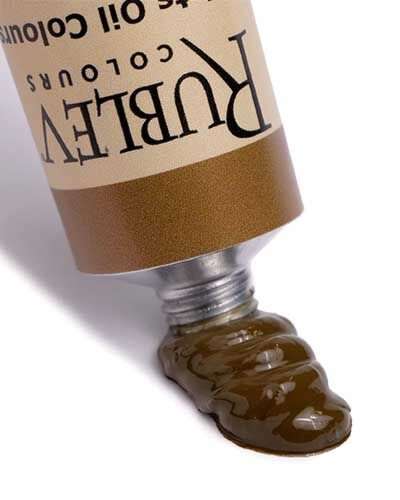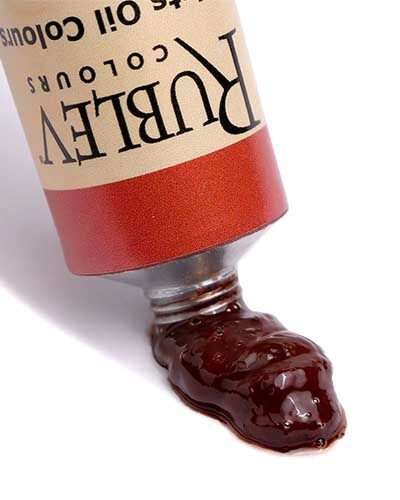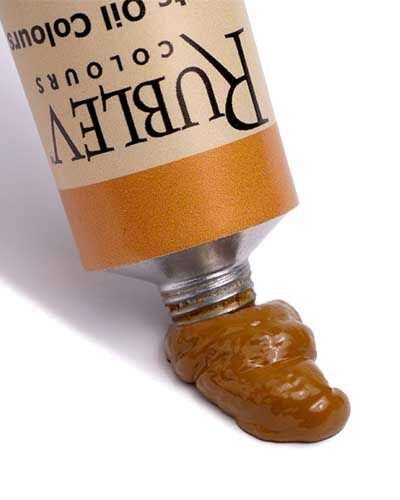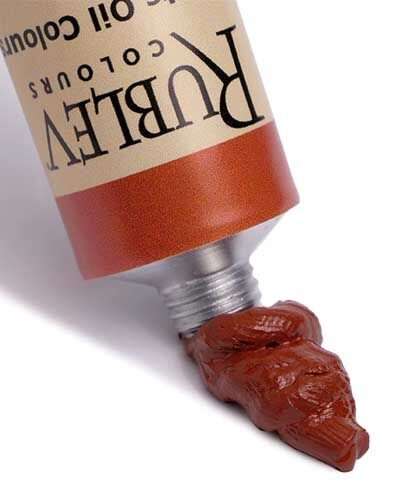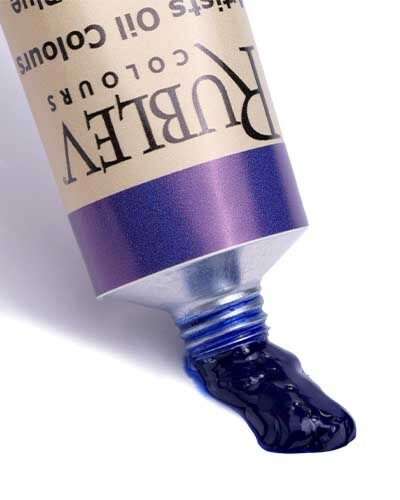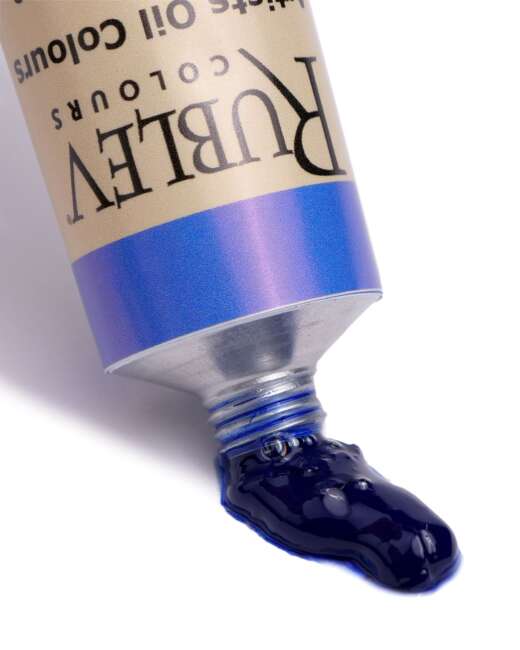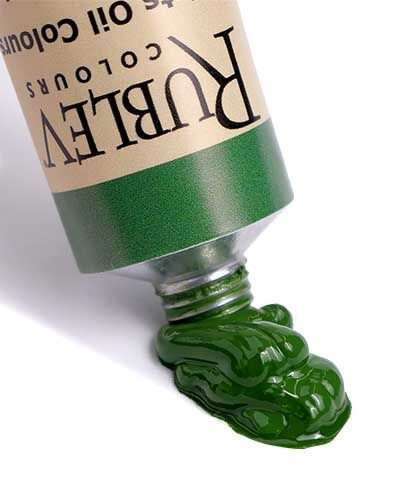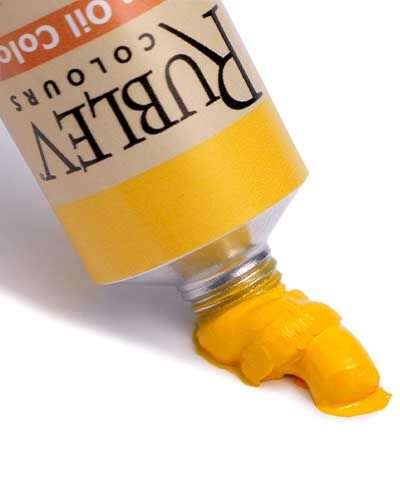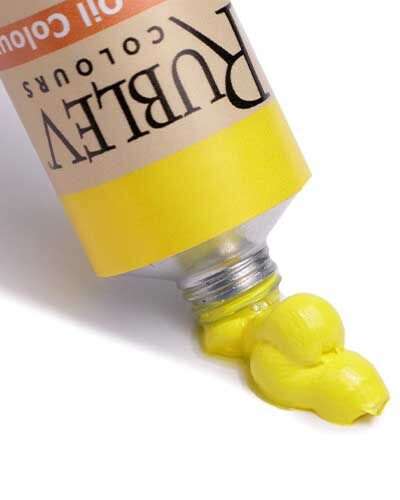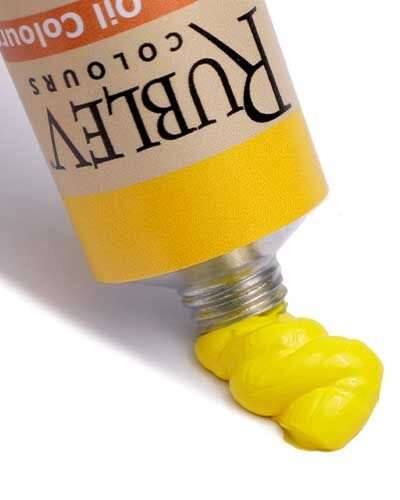The best oil-based paint depends on the artist's specific needs and preferences. Professional grades of artist oils include Rublev Colours Artist Oils, Williamsburg Oil Colors, and Winsor & Newton Artist Oils.
Modern Oil Paints: Understanding Sensitivity to Moisture and Cleaning Solvents

In a comprehensive study titled “Sensitivity of Oil Paint Surfaces to Aqueous and Other Solvents,” researchers Hannah Tempest, Aviva Burnstock, Polly Saltmarsh, and Klaas Jan van den Berg delve into how modern commercially produced oil paints react to various cleaning solvents. For artists, this study offers vital information on paint formulations, their vulnerability to cleaning methods, and best practices for preserving artwork.
The Problem with Modern Oil Paints
Artists most often use modern oil paints for their artwork. However, the study reveals that these paints can be surprisingly sensitive to water and other solvents. Notably, pigments like ultramarine, chromium oxide green, and cadmium yellows exhibit significant sensitivity, which can lead to the degradation of artwork when improper cleaning methods are employed.
Description of Modern Oil Paints Analyzed
The researchers focused on oil paints that include various additives and pigments. The paints were prepared based on formulations from several artist paint companies, ensuring a representative sample of modern oil paints.
Materials in Modern Oil Paint Samples
Linseed Oil is the primary binding medium used in cold-pressed and alkali-refined forms.
Pigments: Key pigments tested included ultramarine (three different shades), chromium oxide green, and raw sienna.
Additives
Hydrogenated Castor Oil: Used in proportions ranging from 1% to 10%.
Linseed Fatty Acids: Added in amounts between 2% and 5%.
Aluminum Hydroxide: Included in concentrations from 5% to 30%.
Aluminum Stearate: Used in varying amounts from 2% to 30%.
Zinc Stearate: Incorporated specifically in ultramarine paints, in proportions from 2% to 30%.
These materials were mixed using an automatic muller, mimicking the industrial three-roller mills used in paint manufacturing. The paints were then applied on different substrates, including commercially prepared cotton canvas and Melinex, and artificially aged to simulate long-term conditions.

The graph above from the article shows the relative percentage by weight (vertical axis) of ultramarine pigment (light blue), drying oil (purple), and zinc stearate additive (cream) in test batches of paint. The percentage weight of zinc stearate additive increases from 0% to 30% in the graph. Note that the pigment content decreases as the zinc stearate increases from left to right, whereas the amount of oil remains relatively constant.
Key Findings on Paint Sensitivity
The researchers prepared and tested oil paint films from twentieth-century manufactured paints, incorporating known proportions of various pigments and additives. After artificial aging, these films were tested for sensitivity to water and other solvents.
Ultramarine and Chromium Oxide Green: These pigments showed high sensitivity to water, with ultramarine being the most affected. Ultramarine paints formed a resistant skin that masked underlying water-sensitive paint, complicating cleaning efforts.
Ultramarine test paints in oil medium on canvas, without additives, were highly sensitive to both saliva and water. Commercial tube paints exhibited similar sensitivity, attributed to the hydrophilic nature of the ultramarine pigment and the absorption of the medium by the support, resulting in less well-bound films. The addition of aluminum stearate to ultramarine and oil had minimal impact on reducing sensitivity, while zinc stearate significantly decreased sensitivity, particularly in subsequent tests. Notably, the combined addition of aluminum stearate and aluminum hydroxide created films that were more resistant to saliva and water. Adding zinc stearate in conjunction with aluminum hydroxide also reduced sensitivity, though to a lesser extent.
Additives Influence Sensitivity: The inclusion of aluminum hydroxide and linseed fatty acids in paint formulations increased their sensitivity to water. Conversely, combining aluminum stearate with these additives often reduced sensitivity, highlighting the complex interplay of materials in paint durability.
Environmental Impact: Fluctuations in environmental conditions or previous treatments can accelerate the migration of degraded components to the paint surface, increasing water sensitivity.
In a survey of painting conservators, modern tube colors such as cadmium and chrome yellows and reds, ultramarine, cobalt blue, chromium oxide green, and purple pigments like cobalt violet were frequently cited as problematic due to their sensitivity to water. While water sensitivity is not typically observed in paints containing earth pigments, conservators cautiously handle these. Sensitivity has been noted in oil paint films with various surface effects, particularly those with efflorescence. This efflorescence is often linked to water sensitivity and is believed to result from fluctuations in environmental moisture, which may accelerate the migration of degraded components to the paint surface. Additionally, water sensitivity has been observed in tacky paint films, often modified with other media by artists, or due to the plasticizing effects of metal stearates and the low pigment volume concentration these stearates enable.

Images from the article show localized efflorescence on (left) chromium oxide green and 20% aluminum stearate and (right) Winsor & Newton Winton French Ultramarine and 20% aluminum stearate.
Artist Paint Companies Consulted
The study drew on technical information and sample formulations from several prominent artist paint manufacturers:
Old Holland: Provided raw materials and an automatic muller for paint preparation.
Winsor & Newton: Contributed expertise on pigments and the paint manufacturing process.
Michael Harding: Consulted for technical details on paint formulations.
Haagsche Kunstschildersverven Fabriek: Historical formulations were analyzed, although the company is no longer available.
Other Consulted Experts: The study also benefitted from insights shared by Ian Garrett and Peter Waldron of Winsor & Newton, Dave Masterman of Holliday Pigments, and Eva Eis of Kremer Pigmente, among others.
Practical Implications for Artists
For practicing artists, the study’s findings emphasize the importance of understanding the materials used in their paints and how they interact with cleaning solvents. Here are some practical takeaways:
Choice of Pigments: Be cautious with pigments known for their water sensitivity, like ultramarine and chromium oxide green. These pigments require more careful handling and specific cleaning techniques.
Additive Awareness: Recognize the role of additives like aluminum stearate and aluminum hydroxide in your paints. While some additives can enhance the paint’s resistance to solvents, others might increase vulnerability, particularly to water.
Cleaning Practices: Avoid using aqueous solvents indiscriminately on oil paintings. Before cleaning, consider the paint composition and the specific sensitivity of the pigments. For sensitive areas, test cleaning methods on a small, inconspicuous section first.
Techniques for Conservation
For those involved in the cleaning and conservation of modern oil paintings, the study suggests several approaches:
Swab Rolling Technique: Use minimal pressure and test various solvents, including deionized water, saliva, and iso-octane, to determine the safest cleaning method for each specific paint formulation.
Monitoring Environmental Conditions: Maintain stable environmental conditions to minimize the risk of component migration and efflorescence on the paint surface.
Developing New Methods: Innovative cleaning methods and materials tailored to the unique challenges presented by modern oil paints are needed. Continued research and development in this area are essential.
Insights into the Sensitivity of Modern Oil Paints
The study on the sensitivity of modern oil paints to cleaning solvents concluded several important points for artists to consider. Adding aluminum hydroxide and linseed oil fatty acids, even when combined with hydrogenated castor oil, increases the water sensitivity of oil paints. However, incorporating aluminum stearate generally reduces this sensitivity. Ultramarine paints with added stearates form a protective skin, but the underlying paint remains sensitive to water, leading to potential damage during cleaning.
Metal stearates can plasticize paint and slow drying, causing free fatty acids to migrate to the surface, especially under normal environmental conditions and cleaning treatments. This migration results in localized efflorescence when using aqueous solvents. Combining aluminum hydroxide and metal stearates can mitigate these effects, acting as stabilizers.
Artists should note that specific pigment and additive combinations increase water sensitivity. Poor drying pigments and low pigment volume concentrations, enabled by metal stearates, create a soft, sticky film vulnerable to swelling by solvents. This study highlights the need for artists to scrutinize brands of modern oil paints, considering the presence of additives like metal stearates and aluminum hydroxide, which impact the paint’s stability and sensitivity to cleaning methods. Future research will further explore the aging properties and behaviors of these additives, including the effects of surfactants and bulking agents on oil paint films.
The study “Sensitivity of Oil Paint Surfaces to Aqueous and Other Solvents” provides critical insights into the complexities of modern oil paints and their interactions with cleaning solvents. For artists, understanding these dynamics is crucial for preserving the longevity and integrity of their work. By selecting pigments carefully, being aware of additives, and employing thoughtful cleaning practices, artists can better safeguard their masterpieces against the ravages of time and solvent exposure.
Are Modern Oil Paints Available Without Additives?
Rublev Colours Artists Oils are Traditional Oil Paints
Why are Rublev Colours different from other modern commercial oil colors? One reason is that we use natural pigments or historical reproductions of pigments used by the old masters. Another reason is that we make Rublev Colours Artists’ Oils as they did before modern tube colors—without additives. Rublev Colours Artists Oils are formulated to maintain the unique characteristics of each pigment in oil. The character in each tube of our oil colors is unique due to the pigment inside, giving the artist nearly limitless choices of texture, opacity, consistency, tone, and hue. With Rublev Colours, you experience the transparency of yellow ocher, the pale coolness of green earth, and the crystalline glitter of deep blue azurite.
The particles of natural pigments are at least six times the diameter of most synthetic pigments in modern artists’ colors. However, when we remember how predominantly crystalline or semi-crystalline pigments, such as azurite, malachite, lazurite, and so on, were used in old masters’ paintings, it is easy to understand how these beautiful surfaces with broken lights were obtained. An examination, for instance, of the surface of azurite blue under the microscope at once reveals the beautiful mass of blue and blue-green crystals, reflecting light in all directions and thus, of course, enhancing the decorative effect.
Pure Oil Color, No Additives
Rublev Colours Artists’ Oils do not contain additives, such as fillers, driers, and stabilizers—simply pigment and oil. We use refined linseed oil in our paint, sometimes with a small amount of heat-bodied linseed oil. Stabilizers, such as stearates and waxes, are not added, which diminishes the individual effects of pigments in oil. You will not find aluminum hydroxide or added linseed fatty acids in Rublev Colours. Therefore, you will find different consistencies from color to color due to the individual pigment characteristics and an occasional bit of free oil. Some colors brush out long, others short and buttery, and others are thixotropic.
Overall, Rublev Colours Artists’ Oils have a longer brushing consistency than most tube colors available today, making them ideal for bristle and soft-hair brushes in fine rendering and old master-like effects on canvas and panels.
Learn More About Rublev Colours Artist Oils
Reference
Tempest H., Burnstock A., Saltmarsh P., van den Berg KJ., Sensitivity of oil paint surfaces to aqueous and other solvents, 2013, in: New Insights into the cleaning of paintings. Proceedings from the cleaning 2010 international conference Universidad Politécnica de Valencia and Museum Conservation Institute. Smithsonian Institution Scholarly Press, Washington DC, pp. 107-117 Download Paper
Further Reading
Burnstock, A., K. J. van den Berg, S. de Groot, and L. Wijnberg. 2007. “An Investigation of Water Sensitive Oil Paints in Twentieth-Century Paintings.” In Modern Paints Uncovered: Proceedings from the Modern Paints Uncovered Symposium, ed. T. Learner, P. Smithen, J. W. Krueger, and M.R. Schilling, pp. 177–188. Los Angeles: Getty Conservation Institute.
Gayler, S., A. Burnstock, and A. Vasconcelos. 2008. A Technical Study of Seminal Paintings from the 1960s by Robyn Denny in the Modern British Collection at the Gulbenkian Foundation, Lisbon. Zeitschrift für Kunsttechnologie and Konservierung, 22(1):63–72.
Mills, L. 2008. Water-Sensitive Oil Paints: An Experimental Investigation Characterising the Causes of the Phenomena and Analysis of a Case Study Painting Les Animaux, 1961, by Karel Appel. Student research project, Courtauld Institute of Art, London.
Mills, L., A. Burnstock, S. de Groot, L. Megens, M. Bisschoff, H. van Keulen, F. Duarte, and K. J. van den Berg. 2008. “Water Sensitivity of Modern Artists’ Oil Paints.” In Preprints ICOM- CC 15th Triennial Meeting, Volume 2, ed. J. Bridgland, pp. 651–659. New Delhi: Allied Publishers.
Ormsby, B., T. Learner, G. M. Foster, J. R. Druzik, and M. R. Schilling. 2007. “Wet Cleaning Acrylic Emulsion Paint Films: An Evaluation of Physical, Chemical and Optical Changes.” In Modern Paints Uncovered: Proceedings from the Modern Paints Uncovered Symposium, ed. T. Learner, P. Smithen, J. W. Krueger, and M. R. Schilling, pp. 189–200. Los Angeles: Getty Conservation Institute.
Tempest, H. 2009. Water-Sensitive Oil Paint: An Experimental Investigation, with Case Studies and Survey, Further Characterising the Causes of the Phenomenon. Student research project report, Courtauld Institute of Art, London.
Tumosa, C. S. 2001. A Brief History of Aluminum Stearate as a Component of Paint. WAAC Newsletter, 23(3). http://cool.conservation- us.org/waac/wn/wn23/wn23- 3/ (accessed 12 November 2012).
Wijnberg, L., K. J. van den Berg, A. Burnstock, and E. Froment. 2007. Jasper Johns’ Untitled 1964–65. Art Matters: Netherlands Technical Studies in Art, 4:68–80.
Frequently Asked Questions
Who has the best oil-based paint?
What is the most realistic oil painting in the world?
Determining the most realistic oil painting in the world is subjective and varies based on personal taste. Some notable examples of highly realistic oil paintings include “Girl with a Pearl Earring” by Johannes Vermeer and “The Arnolfini Portrait” by Jan van Eyck, both renowned for their exquisite detail and lifelike representation.
Is oil painting still relevant?
Yes, oil painting remains highly relevant in contemporary art. It continues to be a popular medium among artists for its versatility, rich colors, and depth. Modern oil paints and techniques keep evolving, allowing artists to explore new styles and expressions.



